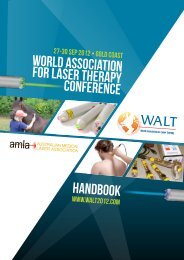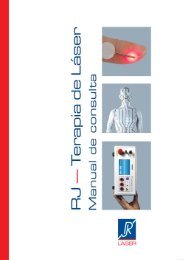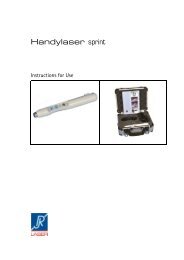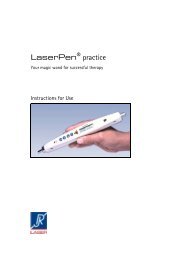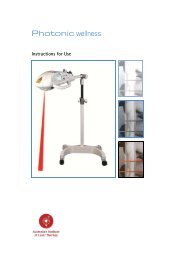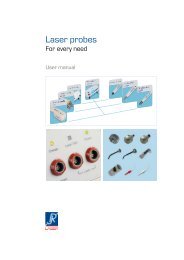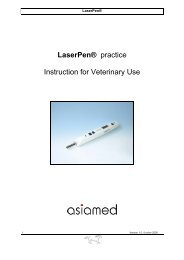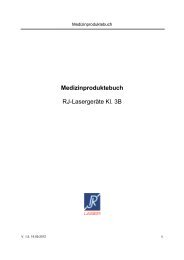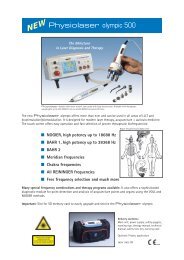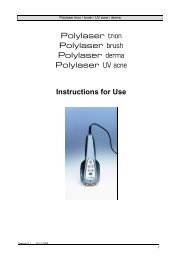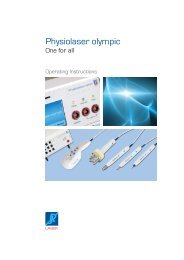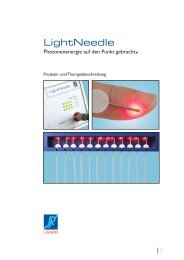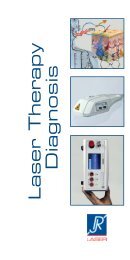LightNeedle - RJ Laser
LightNeedle - RJ Laser
LightNeedle - RJ Laser
Create successful ePaper yourself
Turn your PDF publications into a flip-book with our unique Google optimized e-Paper software.
Abstracts <strong>Laser</strong> Acupuncture<br />
Effects on Acupuncture, Acupressure and <strong>Laser</strong>needle acupuncture on EEG<br />
bispectral index and spectral edge frequency on healthy volunteers.<br />
G. Litscher<br />
University of Graz, Department of Biomedical Engineering and Researchin Anesthesia and Intensive<br />
Care, Graz, Austria<br />
Summary: Background and objective: The main purpose of this study was to investigate the effects<br />
of sensory (acupressure and acupuncture) and optical stimulation (<strong>Laser</strong>needle@ acupuncture)<br />
on electroencephalographic bispectral index, spectral edge frequency and a verbal sedation<br />
score.<br />
Methods: Twenty-five healthy volunteers (mean age :!: SD: 25.5 :!: 4.0yr) were investigated<br />
during the awake state. The acupuncture point Yintang and a placebo control point were stimulated.<br />
The study was performed as a randomized, controlled and partly blinded cross-over trial.<br />
Results: Bispectral index and spectral edge frequency values both decreased significantly (P <<br />
0.001) during acupressureonYintang tovalues of62.9 (minimum 35) :!: 13.9 bispectral indexand<br />
to 13.3 (minimum 2.9) :!: 8.1 Hz (spectral edge frequency right) and 13.8 (minimum 2.7) :!: 7.3<br />
Hz (spectral edge frequency left), respectively.<br />
Bispectral index was also significantly (P < 0.05) affected by <strong>Laser</strong>needle@ acupuncture and<br />
acupressure on the control point but the changes were not clinically relevant, 95.4 :!: 4 and 94.2<br />
:!: 4.8, respectively. All interventions significantly (Yintang: p < 0.001; control point: p < 0.012)<br />
reduced verbal sedation score.<br />
Conclusions: The study highlights the electroencephalographic similarities of acupressure induced<br />
sedation and general anaesthesia as assessed by bispectral index and spectral edge<br />
frequency.<br />
Biological Effects of Painless <strong>Laser</strong> Needle Acupuncture<br />
Gerhard Litscher, PhD Lu Wang, MD Detlef Schikora, PhD Dagmar Rachbauer, MSc Gerhard<br />
Schwarz, MD Andreas Sch�pfer, MD, Stefan Ropele, PhD Evamaria Huber<br />
Summary: <strong>Laser</strong> needle acupuncture is a new method to stimulate acupuncture points. We<br />
describe the technique, its first use, and its value in acupuncture research. <strong>Laser</strong> needle publications<br />
we included are based on 511 measurements in 231 healthy volunteers (129 female, 102<br />
male), with a mean (SD) age of 25 (3.5) years (range, 18-38 years). One pig experiment is also<br />
included.<br />
Results: The results of randomized, double-blind, controlled, crossover studies show that the<br />
methods of laser Doppler flowmetry, functional multidirectional transcranial Doppler sonography,<br />
functional magnetic resonance imaging, and near infrared spectroscopy are able to objectify<br />
and quantify peripheral and cerebral effects of laser needle acupuncture.<br />
Conclusion: For the first time, we were able to investigate scientifically the differences between<br />
needle acupuncture, which includes pain stimulation, and laser needle acupuncture, a continuous<br />
multichannel method of painless acupuncture stimulation. <strong>Laser</strong> needle acupuncture can<br />
induce specific, reproducible changes in the brain. These can be expressed by shifts in different<br />
parameters, such as cerebral blood flow velocity.<br />
11



